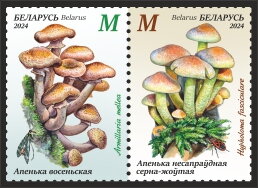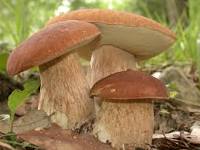Se-tenant: Honey Fungus - Sulphur Tuft (Belarus 2024)
Honey Fungus - Sulphur Tuft (Belarus 2024)
02 August (Belarus ) within release Look-Alike Mushrooms goes into circulation Se-tenant Honey Fungus - Sulphur Tuft face value 2*M No Face Value
| Se-tenant Honey Fungus - Sulphur Tuft in catalogues | |
|---|---|
| Belarus post Inc.: | BLR: BY 1584-1585 |
| Colnect codes: | Col: BY 2024.08.02-03 |
Se-tenant is horizontal format.
Issued in sheets of 8 (4 x 2) stamps - 4 Se-tenant Tete-Beche pairs. Initial value on day of issue: 2*2.34 Br.Also in the issue Look-Alike Mushrooms:
- Stamp - Bitter Bolete face value M;
- Stamp - Chanterelle face value M;
- Se-tenant - Chanterelle - False chanterelle face value 2*M;
- Full Pane - Chanterelle - False Chanterelle face value 8*M;
- Stamp - False Chanterelle face value M;
- Stamp - Honey Fungus face value M;
- Se-tenant - Honey Fungus - Sulphur Tuft face value 2*M;
- Full Pane - Honey Fungus - Sulphur Tuft face value 8*M;
- Souvenir Sheet - Look-Alike Mushrooms face value 6*M;
- Stamp - Penny Bun face value M;
- Se-tenant - Penny Bun - Bitter Bolete face value 2*M;
- Full Pane - Penny Bun - Bitter Bolete face value 8*M;
- Stamp - Sulphur Tuft face value M;
Se-tenant Honey Fungus - Sulphur Tuft it reflects the thematic directions:
A mushroom (or toadstool) is the fleshy, spore-bearing fruiting body of a fungus, typically produced above ground on soil or on its food source. The standard for the name "mushroom" is the cultivated white button mushroom, Agaricus bisporus; hence the word "mushroom" is most often applied to those fungi (Basidiomycota, Agaricomycetes) that have a stem (stipe), a cap (pileus), and gills (lamellae, sing. lamella) on the underside of the cap. These gills produce microscopic spores that help the fungus spread across the ground or its occupant surface. "Mushroom" describes a variety of gilled fungi, with or without stems, and the term is used even more generally, to describe both the fleshy fruiting bodies of some Ascomycota and the woody or leathery fruiting bodies of some Basidiomycota, depending upon the context of the word. Forms deviating from the standard morphology usually have more specific names, such as "bolete", "puffball", "stinkhorn", and "morel", and gilled mushrooms themselves are often called "agarics" in reference to their similarity to Agaricus or their order Agaricales. By extension, the term "mushroom" can also designate the entire fungus when in culture; the thallus (called a mycelium) of species forming the fruiting bodies called mushrooms; or the species itself.

